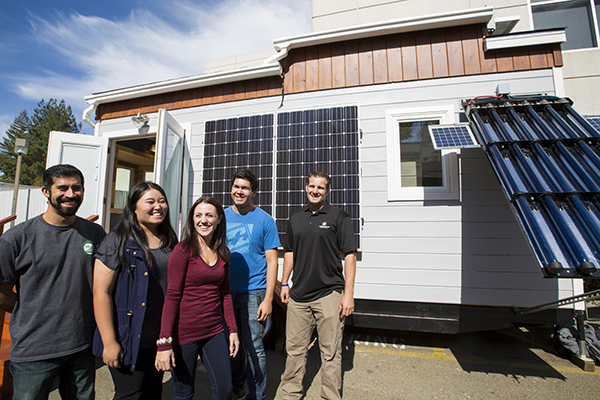Sacramento State’s student-built entry in the SMUD Tiny House Competition is painted a trendy “whale gray” – but the house itself is a minnow.
It’s a cozy, light-filled 184 square feet of sustainable living on wheels.
Step through the French doors, and you’re in the efficient mini kitchen with a desk/dining space in a bay window. A few steps away is the living “room,” and a heartbeat beyond that is the bathroom. Shimmy up the ladder to the sleeping loft, and stretch out on a queen-size mattress.
The design is rustic/contemporary. A bounty of windows provide fresh air and natural light. The wood accents are fashioned from reclaimed pallets. The kitchen sink is recycled. Storage options are minimal but well-thought-out. The innovative vacuum-tube solar system will provide plenty of hot running water.
 From left, students Jesus Guerro, tiny house safety manager; Kristi Phu, project manager; Michelle Feasby, interior architect; and Jose Iniguez, structural engineer, join with Rustin Vogt, professor of mechanical engineering, in front of the completed tiny house. (Sacramento State/Jessica Vernone)
From left, students Jesus Guerro, tiny house safety manager; Kristi Phu, project manager; Michelle Feasby, interior architect; and Jose Iniguez, structural engineer, join with Rustin Vogt, professor of mechanical engineering, in front of the completed tiny house. (Sacramento State/Jessica Vernone)The net-zero energy tiny house was designed by interior architecture student Michelle Feasby with input from the rest of the Sac State Tiny Team, and was built over the past three months by 24 students and alumni from the Mechanical Engineering, Civil Engineering, and Construction Management departments.
“I’ve learned a lot from being a part of the construction team,” says Feasby. “I’ve been able to delegate – seeing the vision of what needs to happen next, and answering questions of the other volunteers. It’s been a fun exercise, because project management is something I can see myself doing.”
SMUD challenged 10 California collegiate teams to design and build affordable, livable, and innovative net-zero energy homes on trailers. The houses are no more than 400 square feet and cost less than $25,000 in materials.
Student teams will conduct public tours of their tiny houses during SMUD’s free Tiny House Energy Showcase, 9 a.m. to 4 p.m. Saturday, Oct. 15, at Cosumnes River College, 8401 Center Parkway.
In addition to Sac State, the competitors are: Chico State, Fresno State, Cosumnes River College, Laney College, College of the Sequoias, UC Berkeley, Santa Clara University, San Jose City College, and UC Santa Cruz/Cabrillo College.
Teams are vying for $30,000 in prizes. Winners will be announced at the showcase.
SMUD modeled its inaugural Tiny House Competition on the U.S. Department of Energy’s Solar Decathlon. Teams will be judged on criteria such as architectural design, energy efficiency, home life, and communications.
“Our students learned about practical project management, project design, and the experience of building something tangible that has an intended net-zero use,” says Rustin Vogt, a professor of mechanical engineering and advisor to Sac State’s Tiny Team. “When we cut the trailer apart, we had students who had never used a cutting torch or a grinding wheel. And now, they’re versed in every stage of a sustainable build.”
Sac State’s tiny house will be returned to campus after the competition and make its home at STORC, the Sustainable Technology Optimization Research Center, where it will be used as sustainable-living demonstration lab, says Lorenzo Smith, dean of the College of Engineering and Computer Science. – Dixie Reid
